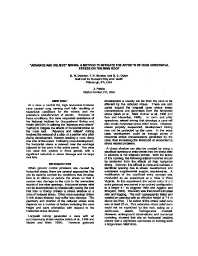Mining Publication: Advance and Relieve Mining: A Method to Mitigate the Effects of High Horizontal Stress on the Mine Roof
Original creation date: February 2001
At a mine in central PA, high horizontal stresses have caused long running roof falls resulting in hazardous conditions for the miners and the premature abandonment of panels. Because of these conditions, the mine requested assistance of the National Institute for Occupational Safety and Health (NIOSH) in utilizing the advance and relieve method to mitigate the affects of horizontal stress on the mine roof. Advance and relieve mining involves the removal of a pillar or a portion of a pillar during development, thereby creating a cave along one side of the panel. Following cave development, the horizontal stress is relieved over the workings adjacent to the cave in the active panel. The mine has used this system in three panels with a significant reduction in stress damage and no large roof falls.
Authors: DR Dolinar, TP Mucho, DC Oyler, J Pablic
Conference Paper - February 2001
NIOSHTIC2 Number: 20021292
SME, Inc., Preprint 01-113, SME Annual Meeting, Denver, Colorado - February 26-28, 2001; :1-12
See Also
- Analysis of Pillar Design Practices and Techniques for U.S. Limestone Mines
- Effects of Weak Bands on Pillar Stability in Stone Mines: Field Observations and Numerical Model Assessment
- Field Observations and Numerical Studies of Horizontal Stress Effects on Roof Stability in U.S. Limestone Mines
- Horizontal Stress
- In Situ Stress Measurements Near the Ross Shaft Pillar, Homestake Mine, South Dakota
- Investigation of Pillar-Roof Contact Failure in Northern Appalachian Stone Mine Workings
- Optimizing Secondary Roof Support with the NIOSH Support Technology Optimization Program (STOP)
- Pillar Stability Issues Based on a Survey of Pillar Performance in Underground Limestone Mines
- Proceedings: New Technology for Ground Control in Multiple-seam Mining
- Technology News 483 - Safety Training Tools for Rock Scaling Personnel
- Page last reviewed: 9/21/2012
- Page last updated: 9/21/2012
- Content source: National Institute for Occupational Safety and Health, Mining Program


 ShareCompartir
ShareCompartir
